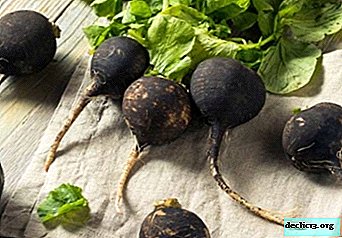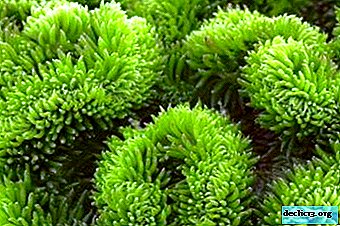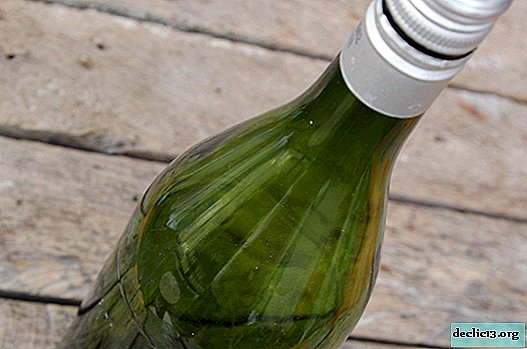The chemical composition and calorie content of radish. What is important to know about the product?

Radish has a number of essential amino acids, vitamins and mineral salts necessary to maintain overall metabolism. Vegetable culture helps to eliminate toxins and toxins, is used in folk medicine for the treatment of infectious and inflammatory diseases.
But despite the benefits, before including the root crop in the main menu, you should familiarize yourself with its composition. This will avoid the negative effects of the use of radish in the presence of contraindications.
Why is it important to know the components of a product?
Through familiarization with vitamins and minerals contained in the product, you can learn about its benefits to the body. This allows you to properly compose a daily menu, providing yourself with all the necessary nutrients. A balanced diet is especially important for people suffering from chronic diseases. They need to know the calorie content, the ratio of proteins, fats and carbohydrates of a vegetable crop.
Radish brings both benefits and harm to the body. Therefore, you should familiarize yourself with contraindications to a herbal product and possible side effects.Ingredients and Nutrition Facts
Vitamins, oils, acids and minerals in the composition of the product determine its beneficial properties for the body.
 The root crop contains:
The root crop contains:
- tanning components;
- ash;
- micro and macro elements;
- vitamins A, B, C, E;
- saccharides;
- coarse fiber;
- sulfur compounds;
- a number of essential amino acids.
Due to the high content of essential oils, radish has a special aroma and exhibits bactericidal properties.
To saturate the body with the daily rate of ascorbic acid, you will need to eat 150 g of radish.
Calorie content and BJU
Fresh
The energy value per 100 g of the product is 34.5 kcal. It consists of:
- 1.9 g of protein;
- 0.2 g of fat;
- 6.7 g of carbohydrates.
Marinated
When pickling a vegetable crop, a mixture of vinegar, vegetable oil with salted water is used. As a result, the amount of fat in the radish increases to 2.5 g, and protein and carbohydrate decreases to 1.1 and 4.3 g, respectively. This is due to the fact that part of the saccharides and amino acids are destroyed by the action of acetic acid.
The remaining radish is soaked in oil and the fats contained in it.. As a result, the calorie content of the product increases to 44.1 kcal per 100 grams of root crops.
In the salad
When calculating how many calories are in a radish salad, it is worth remembering that in addition to the root crop, a dressing of salt, olive oil and sour cream is also added to the dish. However, other vegetables and leafy greens are not taken into account. The nutritional value of the product changes:
- 2.2 g of protein;
- 6.3 g of carbohydrates;
- 19 g of fat.
What vitamins does it contain?
| Vitamin Name | The amount of substance per 100 g of product, mg | Useful properties, role in the body |
| Retinol | 0,003 | Vitamin A promotes the production of growth hormone, growth hormone in childhood. Regulates intracellular metabolism and normalizes the work of the visual analyzer. |
| Thiamine | 0,03 | Vitamin B1 increases the sensitivity of cells to glucose. As a result, sugar is easily absorbed by skeletal muscle fibers and internal organs. Accelerates the transmission of nerve impulses. |
| Riboflavin | 0,03 | Vitamin B2 is responsible for cellular respiration and oxygen transport to all body tissues. Improves the functioning of the optic and oculomotor pair of cranial nerves. |
| Pantothenic acid | 0,18 | Vitamin B5 improves the absorption of nutrients by the microvilli of the small intestine. Regulates serum cholesterol. |
| Pyridoxine | 0,06 | Vitamin B6 enhances cognitive function, prevents the development of ischemic brain disease and improves cerebral circulation. |
| Vitamin C | 29 | Vitamin C increases vascular resistance and improves the activity of immunocompetent cells. |
| Tocopherol | 0,1 | Vitamin E regulates the carbohydrate and lipid metabolism of the body. Strengthens hair and nails, restores skin elasticity, stimulates the synthesis of collagen fibers in subcutaneous fat. |
| Niacin | 0,3 | Vitamin B3 is involved in energy metabolism, controls the plasma concentration of sugar in the blood. |
Glycemic index
The glycemic index (GI) allows you to determine how much plasma sugar concentration will increase after eating radish. Low GI foods are highly digestible. All obtained carbohydrates are processed into energy for muscles, therefore, after 1-2 hours after their use, a person again feels hunger.
Foods with high GI provide the body with excess sugar, which is processed into glycogen by liver cells and is deposited in the form of adipose tissue around the internal organs and under the skin.Radish belong to the first category of products. Her GI is 17 units. Therefore, it can be used for weight loss, vegetables are allowed to eat for people with diabetes or obesity.
Macronutrients
 The composition of 100 g of root crops includes the following macroelements:
The composition of 100 g of root crops includes the following macroelements:
- Potassium. The content of the chemical element differs in different varieties of radish. On average, up to 357 mg of the substance necessary for muscle contraction occurs in radishes. Potassium normalizes the work of the myocardium and regulates vasospasm.
- Sodium. Radish accounts for only 13 mg of the mineral compound. It supports water-electrolyte metabolism in the body.
- Calcium. It is necessary to maintain the bone and cartilage structure of the musculoskeletal system; it regulates the reduction of cardiomyocytes - muscle cells of the heart. 35 mg in the root crop reduce harmful plasma cholesterol.
- Phosphorus. 26 mg of the mineral component stimulates intracellular metabolism, is absorbed by the body to strengthen tooth enamel.
- Magnesium. 22 mg of the substance in vegetable culture improves the functioning of the musculoskeletal and nervous systems.
Trace elements
The product of all trace elements contains only iron. The mineral substance is part of hemoglobin, which binds oxygen molecules to the surface of red blood cells. Participates in cellular respiration and cell nutrition. 100 g of radish accounts for 1.2 mg of iron.
In addition to mineral compounds in small quantities in the root crop contain:
- essential oils - stimulate the production of hydrochloric acid and digestive enzymes, increase appetite, preparing the body for food intake;
- vegetable fiber, freeing the gastrointestinal tract from slag masses and toxic compounds, normalizes serum levels of bad cholesterol;
- lysozyme prevents the growth of pathogens in the human body, has a bactericidal effect on pathogens, relieves swelling of soft tissues.
Benefit and harm
Radish brings the following benefits to the body:

- Normalizes the digestion of food. Helps to eliminate slag masses, prevents the development of constipation and normalizes intracellular metabolism. Vegetable culture supports the natural intestinal microflora.
- It is part of folk remedies for the treatment of cough. Vegetable juice contains essential oils. They relieve inflammation and remove phlegm from the bronchi, enhancing the motility of their smooth muscles, causing them to expectorant mucus and purulent exudate.
- Reduces the risk of developing atherosclerosis. Pantothenic acid, calcium and potassium in the composition of the product reduce the level of bad cholesterol, which in excess can create fatty plaques on the artery wall.
- Improves the condition of hair, skin and strengthens the nail plate. This effect brings radish due to the content of vitamin E. Together with ascorbic acid, tocopherol has an antioxidant effect on the body, slowing down the aging process.
- Vitamins and minerals in the product normalize metabolism, helping to reduce excess weight.
- It has a choleretic, diaphoretic and diuretic effect. As a result, toxins leave the body faster.
- The product contains lysozyme, exhibiting anti-inflammatory effect. It also inhibits the growth of pathogens in the body, reducing the risk of developing infectious diseases.
- Vitamin C strengthens the immune system, relieves swelling and helps to remove excess fluid from the body.
But despite a number of useful properties, radish can harm the body. With abuse of the product, the development of:
- gastritis due to the high content of organic acids and essential oils that increase the acidity of gastric juice;
- hypervitaminosis;
- violation of the stool: constipation, flatulence, diarrhea;
- increased gas formation in the intestine, due to which there is bloating, there is a heaviness in the abdomen.
At the same time, people with some chronic diseases are strictly forbidden to include radish in their diet:

- peptic ulcer of the stomach and duodenum;
- renal and liver failure;
- pregnancy;
- recent stroke, heart attack;
- gout;
- individual intolerance to the product and a tendency to develop allergies;
- cholecystitis.
We suggest watching a video about the benefits of radish and precautions for its use:
With proper use, radish normalizes digestion and improves intracellular metabolism. Vegetable culture increases the activity of immunity, relieves cough and bronchospasm. To get the maximum benefit from the use of the product, it is important to know its composition: calorie content, nutritional value and the vitamins contained in it.

















